2017 NISSAN ALTIMA SEDAN remote start
[x] Cancel search: remote startPage 295 of 497
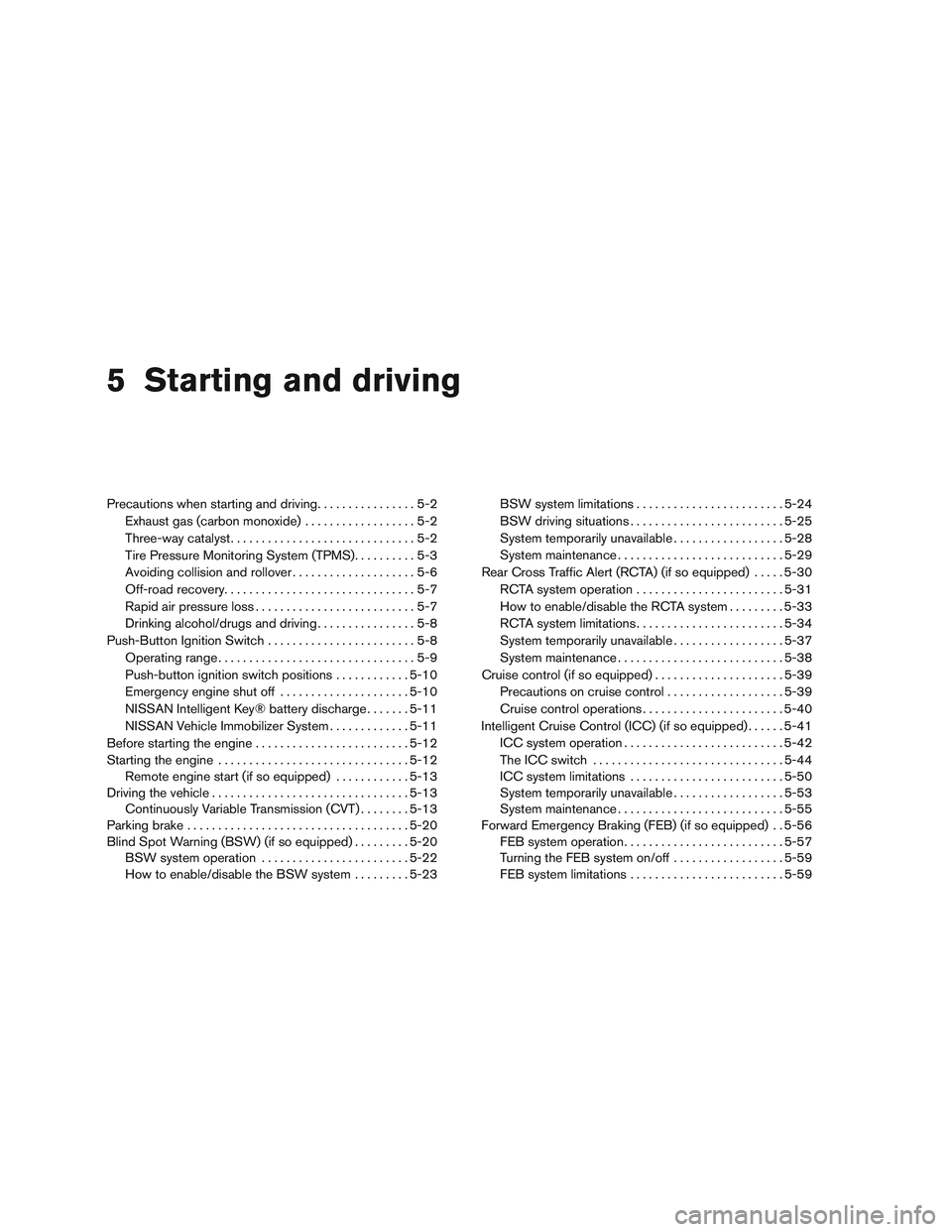
5 Starting and driving
Precautions when starting and driving................5-2
Exhaust gas (carbon monoxide) ..................5-2
Three-way catalyst ..............................5-2
Tire Pressure Monitoring System (TPMS) ..........5-3
Avoiding collision and rollover . . ..................5-6
Off-road recovery ...............................5-7
Rapid air pressure loss ..........................5-7
Drinking alcohol/drugs and driving ................5-8
Push-Button Ignition Switch ........................5-8
Operating range ................................5-9
Push-button ignition switch positions . . . .........5-10
Emergency engine shut off .....................5-10
NISSAN Intelligent Key® battery discharge .......5-11
NISSAN Vehicle Immobilizer System .............5-11
Before starting the engine ......................... 5-12
Starting the engine ............................... 5-12
Remote engine start (if so equipped) . . . .........5-13
Driving the vehicle ................................ 5-13
Continuously Variable Transmission (CVT) ........5-13
Parking brake .................................... 5-20
Blind Spot Warning (BSW) (if so equipped) .........5-20
BSW system operation ........................ 5-22
How to enable/disable the BSW system .........5-23 BSW system limitations
........................ 5-24
BSW driving situations ......................... 5-25
System temporarily unavailable ..................5-28
System maintenance ........................... 5-29
Rear Cross Traffic Alert (RCTA) (if so equipped) .....5-30
RCTA system operation ........................ 5-31
How to enable/disable the RCTA system .........5-33
RCTA system limitations ........................ 5-34
System temporarily unavailable ..................5-37
System maintenance ........................... 5-38
Cruise control (if so equipped) . . ...................5-39
Precautions on cruise control ...................5-39
Cruise control operations .......................5-40
Intelligent Cruise Control (ICC) (if so equipped) ......5-41
ICC system operation .......................... 5-42
The
ICC switch ............................... 5-44
ICC system limitations ......................... 5-50
System temporarily unavailable ..................5-53
System maintenance ........................... 5-55
Forward Emergency Braking (FEB) (if so equipped) . . 5-56 FEB system operation .......................... 5-57
Turning the FEB system on/off ..................5-59
FEB system limitations ......................... 5-59
Page 308 of 497
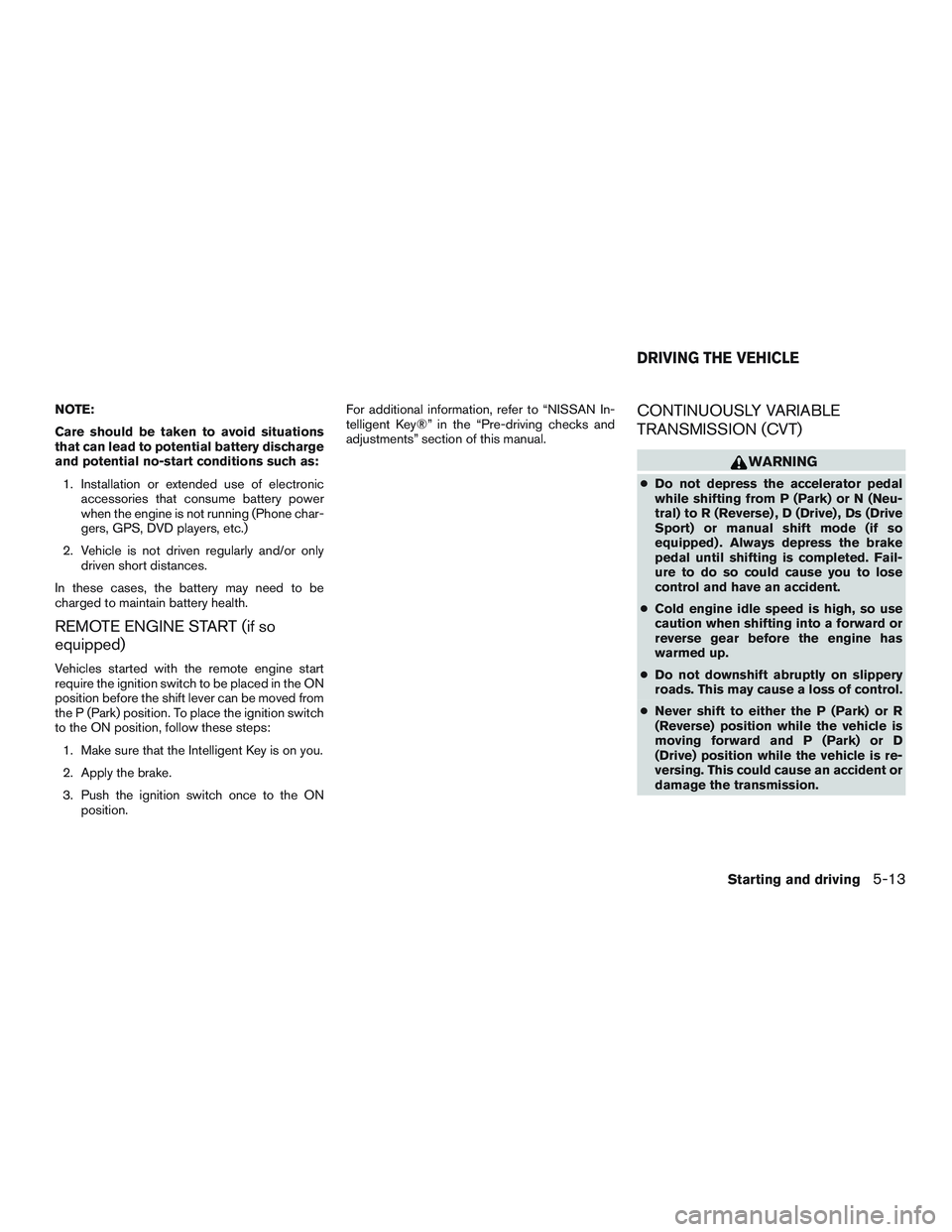
NOTE:
Care should be taken to avoid situations
that can lead to potential battery discharge
and potential no-start conditions such as:1. Installation or extended use of electronic accessories that consume battery power
when the engine is not running (Phone char-
gers, GPS, DVD players, etc.)
2. Vehicle is not driven regularly and/or only driven short distances.
In these cases, the battery may need to be
charged to maintain battery health.
REMOTE ENGINE START (if so
equipped)
Vehicles started with the remote engine start
require the ignition switch to be placed in the ON
position before the shift lever can be moved from
the P (Park) position. To place the ignition switch
to the ON position, follow these steps: 1. Make sure that the Intelligent Key is on you.
2. Apply the brake.
3. Push the ignition switch once to the ON position. For additional information, refer to “NISSAN In-
telligent Key®” in the “Pre-driving checks and
adjustments” section of this manual.
CONTINUOUSLY VARIABLE
TRANSMISSION (CVT)
WARNING
●
Do not depress the accelerator pedal
while shifting from P (Park) or N (Neu-
tral) to R (Reverse) , D (Drive) , Ds (Drive
Sport) or manual shift mode (if so
equipped) . Always depress the brake
pedal until shifting is completed. Fail-
ure to do so could cause you to lose
control and have an accident.
● Cold engine idle speed is high, so use
caution when shifting into a forward or
reverse gear before the engine has
warmed up.
● Do not downshift abruptly on slippery
roads. This may cause a loss of control.
● Never shift to either the P (Park) or R
(Reverse) position while the vehicle is
moving forward and P (Park) or D
(Drive) position while the vehicle is re-
versing. This could cause an accident or
damage the transmission.
DRIVING THE VEHICLE
Starting and driving5-13
Page 382 of 497
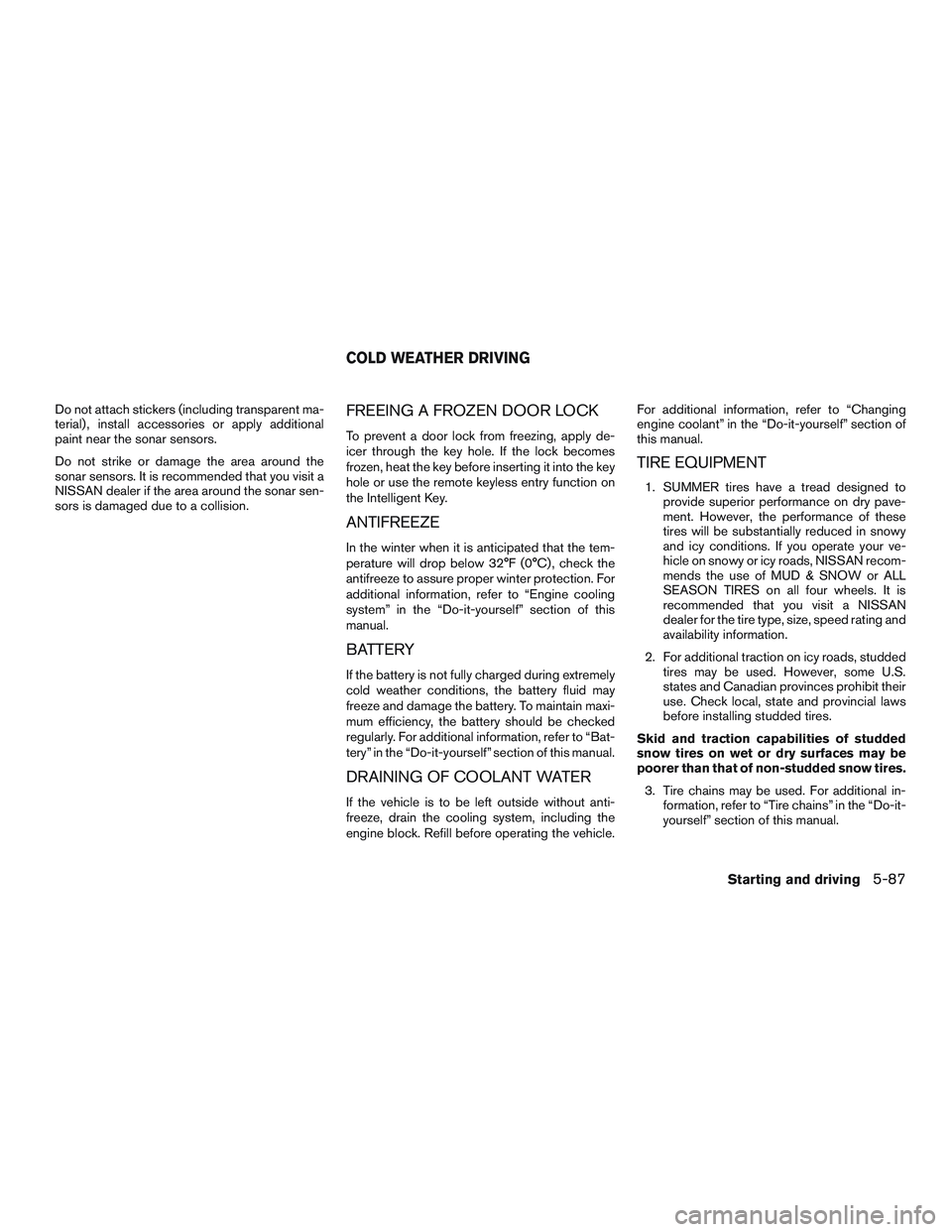
Do not attach stickers (including transparent ma-
terial) , install accessories or apply additional
paint near the sonar sensors.
Do not strike or damage the area around the
sonar sensors. It is recommended that you visit a
NISSAN dealer if the area around the sonar sen-
sors is damaged due to a collision.FREEING A FROZEN DOOR LOCK
To prevent a door lock from freezing, apply de-
icer through the key hole. If the lock becomes
frozen, heat the key before inserting it into the key
hole or use the remote keyless entry function on
the Intelligent Key.
ANTIFREEZE
In the winter when it is anticipated that the tem-
perature will drop below 32°F (0°C) , check the
antifreeze to assure proper winter protection. For
additional information, refer to “Engine cooling
system” in the “Do-it-yourself” section of this
manual.
BATTERY
If the battery is not fully charged during extremely
cold weather conditions, the battery fluid may
freeze and damage the battery. To maintain maxi-
mum efficiency, the battery should be checked
regularly. For additional information, refer to “Bat-
tery” in the “Do-it-yourself” section of this manual.
DRAINING OF COOLANT WATER
If the vehicle is to be left outside without anti-
freeze, drain the cooling system, including the
engine block. Refill before operating the vehicle.For additional information, refer to “Changing
engine coolant” in the “Do-it-yourself” section of
this manual.
TIRE EQUIPMENT
1. SUMMER tires have a tread designed to
provide superior performance on dry pave-
ment. However, the performance of these
tires will be substantially reduced in snowy
and icy conditions. If you operate your ve-
hicle on snowy or icy roads, NISSAN recom-
mends the use of MUD & SNOW or ALL
SEASON TIRES on all four wheels. It is
recommended that you visit a NISSAN
dealer for the tire type, size, speed rating and
availability information.
2. For additional traction on icy roads, studded tires may be used. However, some U.S.
states and Canadian provinces prohibit their
use. Check local, state and provincial laws
before installing studded tires.
Skid and traction capabilities of studded
snow tires on wet or dry surfaces may be
poorer than that of non-studded snow tires. 3. Tire chains may be used. For additional in- formation, refer to “Tire chains” in the “Do-it-
yourself” section of this manual.
COLD WEATHER DRIVING
Starting and driving5-87
Page 490 of 497
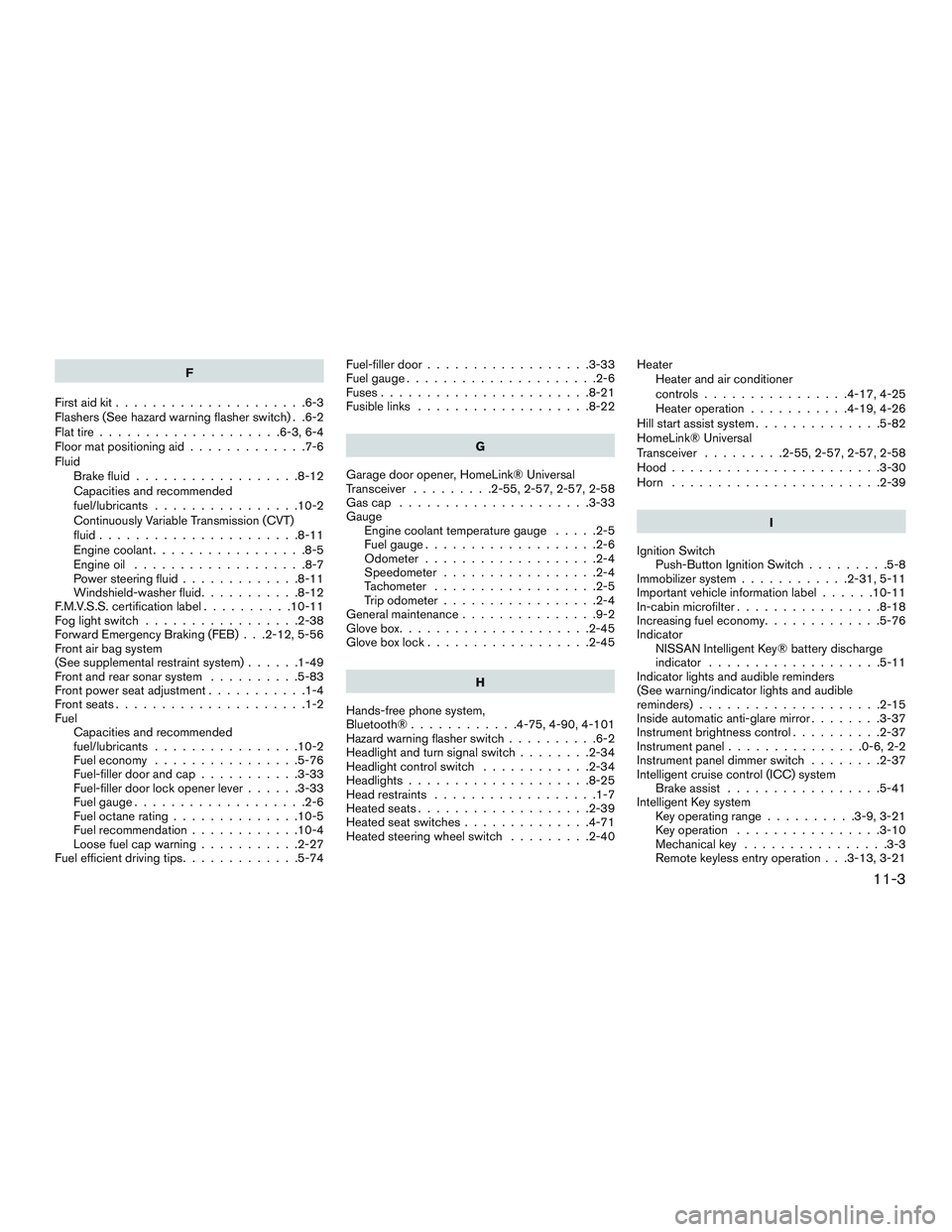
F
First aid kit .....................6-3
Flashers (See hazard warning flasher switch) . .6-2
Flat tire ....................6-3,6-4
Floor mat positioning aid .............7-6
Fluid Brake fluid ..................8-12
Capacities and recommended
fuel/lubricants ................10-2
Continuously Variable Transmission (CVT)
fluid......................8-11
Engine coolant .................8-5
Engine oil ...................8-7
Power steering fluid .............8-11
Windshield-washerfluid...........8-12
F.M.V.S.S. certification label ..........10-11
Foglightswitch .................2-38
Forward Emergency Braking (FEB) . . .2-12, 5-56
Front air bag system
(See supplemental restraint system) ......1-49
Front and rear sonar system ..........5-83
Front power seat adjustment ...........1-4
Frontseats.....................1-2
Fuel Capacities and recommended
fuel/lubricants ................10-2
Fuel economy ................5-76
Fuel-filler door and cap ...........3-33
Fuel-filler door lock opener lever ......3-33
Fuel gauge ...................2-6
Fuel octane rating ..............10-5
Fuel recommendation ............10-4
Loose fuel cap warning ...........2-27
Fuel efficient driving tips .............5-74 Fuel-filler door
..................3-33
Fuelgauge.....................2-6
Fuses.......................8-21
Fusiblelinks ...................8-22
G
Garage door opener, HomeLink® Universal
Transceiver .........2-55,2-57,2-57,2-58
Gascap .....................3-33
Gauge Engine coolant temperature gauge .....2-5
Fuel gauge ...................2-6
Odometer ...................2-4
Speedometer .................2-4
Tachometer ..................2-5
Trip odometer .................2-4
General maintenance ...............9-2
Glovebox.....................2-45
Gloveboxlock..................2-45
H
Hands-free phone system,
Bluetooth®............4-75,4-90,4-101
Hazard warning flasher switch ..........6-2
Headlight and turn signal switch ........2-34
Headlight control switch ............2-34
Headlights ....................8-25
Head restraints ..................1-7
Heated seats ...................2-39
Heated seat switches ..............4-71
Heated steering wheel switch .........2-40Heater
Heater and air conditioner
controls ................4-17,4-25
Heater operation ...........4-19,4-26
Hill start assist system ..............5-82
HomeLink® Universal
Transceiver .........2-55,2-57,2-57,2-58
Hood.......................3-30
Horn .......................2-39
I
Ignition Switch Push-Button Ignition Switch .........5-8
Immobilizer system ............2-31,5-11
Important vehicle information label ......
10-11
In-cabin microfilter ................8-18
Increasing fuel economy .............5-76
Indicator NISSAN Intelligent Key® battery discharge
indicator ...................5-11
Indicator lights and audible reminders
(See warning/indicator lights and audible
reminders)....................2-15
Inside automatic anti-glare mirror ........3-37
Instrument brightness control ..........2-37
Instrumentpanel...............0-6,2-2
Instrument panel dimmer switch ........2-37
Intelligent cruise control (ICC) system Brake assist .................5-41
Intelligent Key system Key operating range ..........3-9,3-21
Key operation ................3-10
Mechanical key ................3-3
Remote keyless entry operation . . .3-13, 3-21
11-3
Page 492 of 497
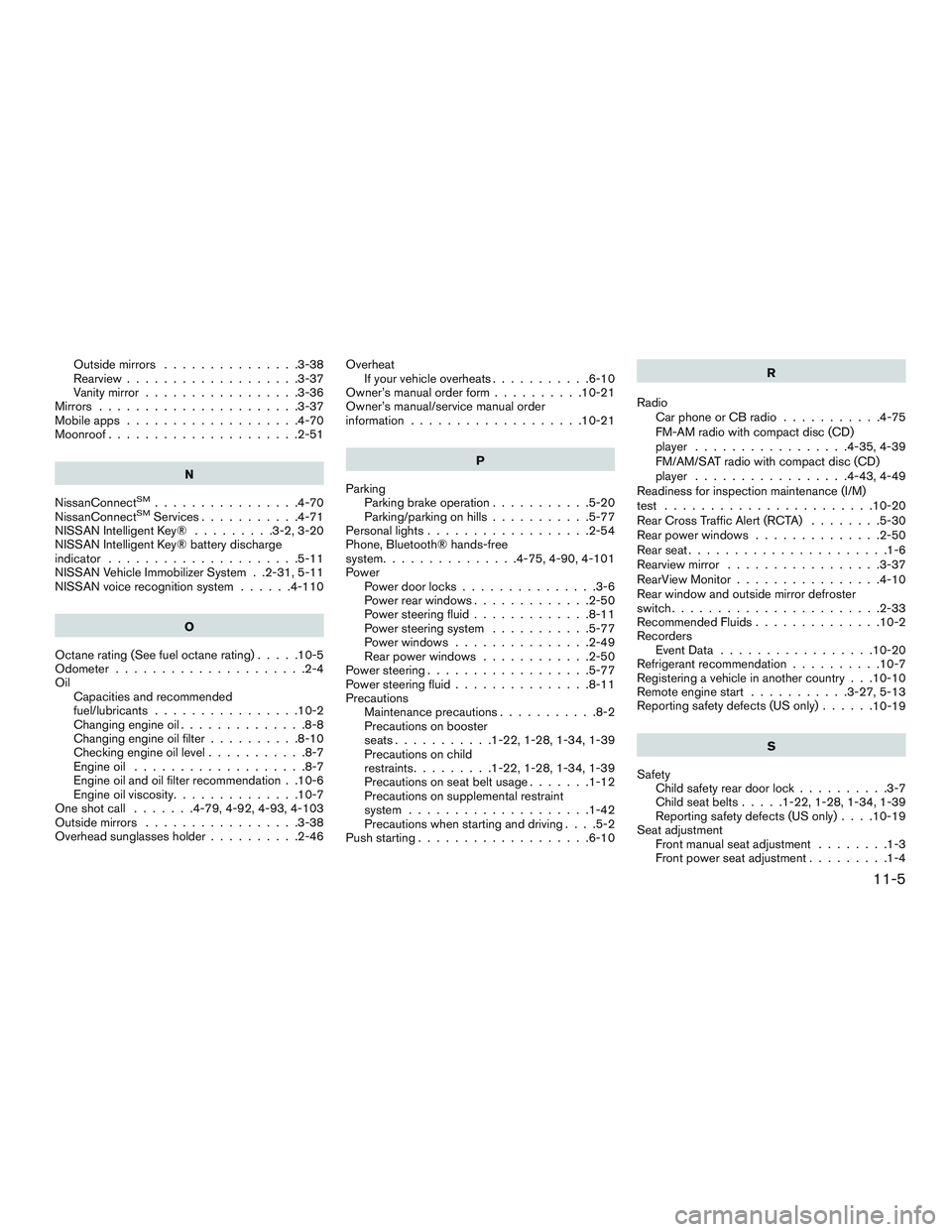
Outside mirrors...............3-38
Rearview ...................3-37
Vanity mirror .................3-36
Mirrors ......................3-37
Mobileapps ...................4-70
Moonroof .....................2-51
N
NissanConnect
SM................4-70
NissanConnectSMServices...........4-71
NISSAN Intelligent Key® .........3-2,3-20
NISSAN Intelligent Key® battery discharge
indicator .....................5-11
NISSAN Vehicle Immobilizer System . .2-31, 5-11
NISSAN voice recognition system ......4-110
O
Octanerating(Seefueloctanerating).....10-5
Odometer .....................2-4
Oil Capacities and recommended
fuel/lubricants ................10-2
Changing engine oil ..............8-8
Changing engine oil filter ..........8-10
Checking engine oil level ...........8-7
Engine oil ...................8-7
Engine oil and oil filter recommendation . .10-6
Engine oil viscosity ..............10-7
Oneshotcall .......4-79,4-92,4-93,4-103
Outside mirrors .................3-38
Overhead sunglasses holder ..........2-46Overheat
If your vehicle overheats ...........6-10
Owner’s manual order form ..........10-21
Owner’s manual/service manual order
information ...................10-21
P
Parking Parking brake operation ...........5-20
Parking/parking on hills ...........5-77
Personallights..................2-54
Phone, Bluetooth® hands-free
system ...............4-75,4-90,4-101
Power Power door locks ...............3-6
Power rear windows .............2-50
Power steering fluid .............8-11
Power steering system ...........5-77
Power windows ...............2-49
Rear power windows ............2-50
Power steering ..................5-77
Power steering fluid ...............8-11
Precautions Maintenance precautions ...........8-2
Precautions on booster
seats...........1-22,1-28,1-34,1-39
Precautions on child
restraints .........1-22,1-28,1-34,1-39
Precautions on seat belt usage .......1-12
Precautions on supplemental restraint
system ....................1-42
Precautions when starting and driving ....5-2
Push starting ...................6-10 R
Radio CarphoneorCBradio ...........4-75
FM-AM radio with compact disc (CD)
player .................4-35,4-39
FM/AM/SAT radio with compact disc (CD)
player .................4-43,4-49
Readiness for inspection maintenance (I/M)
test .......................10-20
Rear Cross Traffic Alert (RCTA) ........5-30
Rear power windows ..............2-50
Rearseat......................1-6
Rearview mirror .................3-37
RearView Monitor ................4-10
Rear window and outside mirror defroster
switch.......................2-33
Recommended Fluids ..............10-2
Recorders EventData .................10-20
Refrigerant recommendation ..........10-7
Registering a vehicle in another country . . .10-10
Remote engine start ...........3-27,5-13
Reporting safety defects (US only) ......
10-19
S
Safety Child safety rear door lock ..........3-7
Child seat belts .....1-22,1-28,1-34,1-39
Reporting safety defects (US only) ....10-19
Seat adjustment Front manual seat adjustment ........1-3
Front power seat adjustment .........1-4
11-5